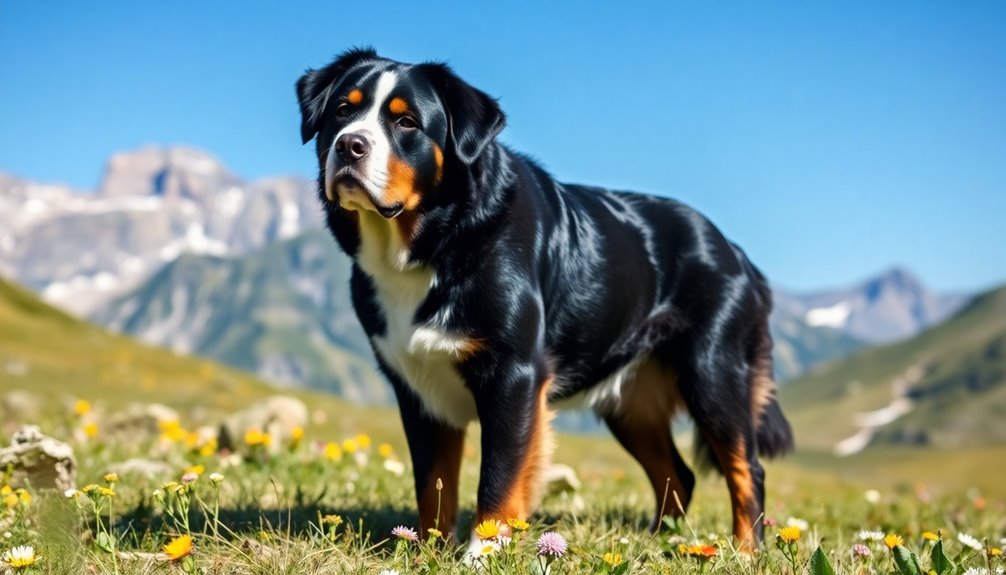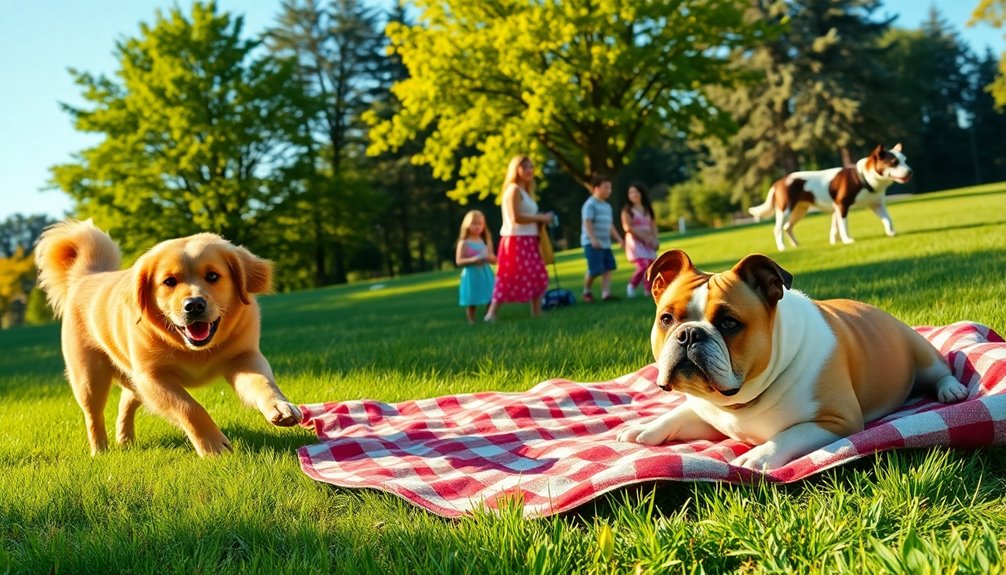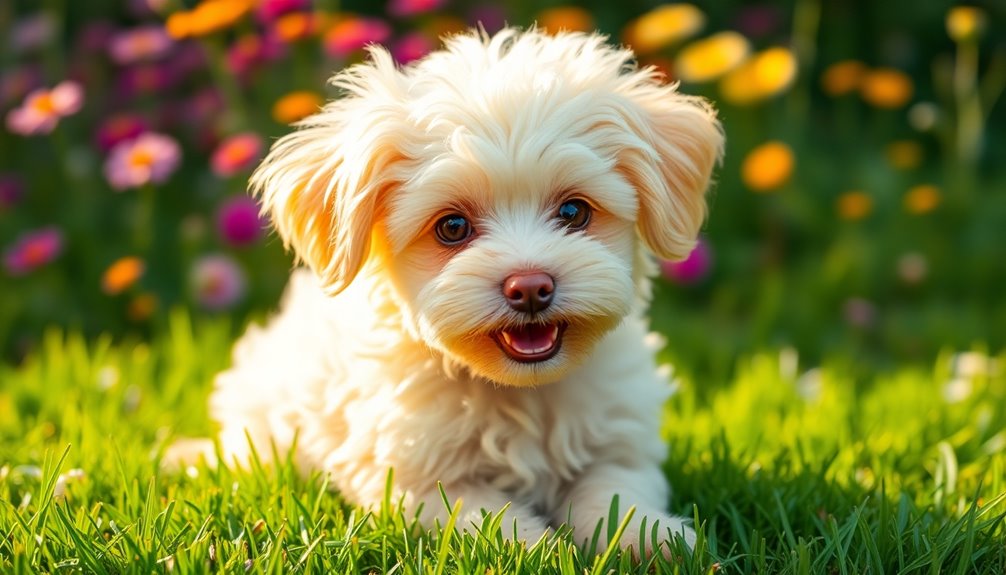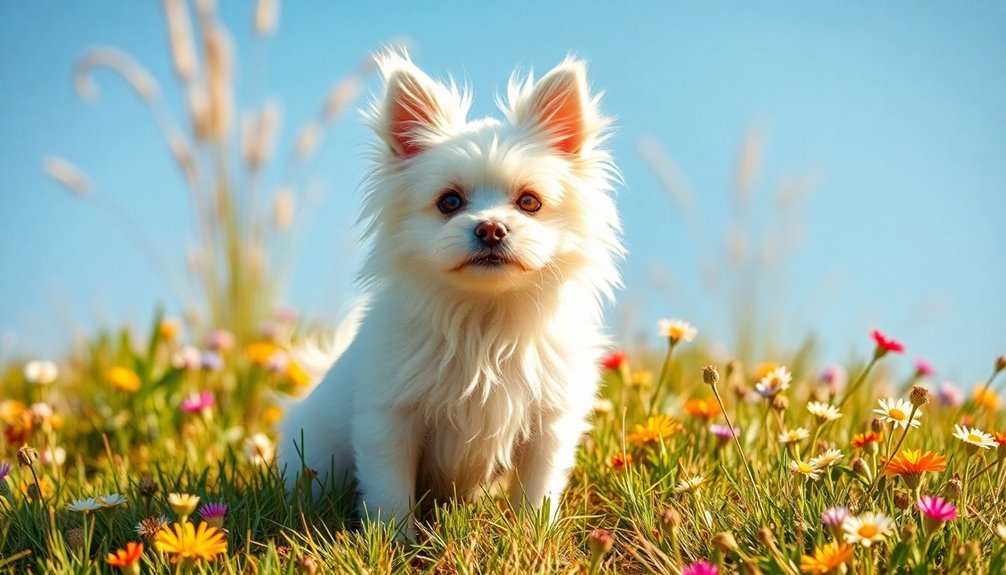The Great Swiss Mountain Dog is a powerful yet gentle companion, perfect for active families. They stand between 24 to 28 inches and weigh 110 to 150 pounds, showcasing their strong build. Friendly and loyal, these dogs are great with children and other pets, embodying the term "gentle giant." They thrive on daily exercise and enjoy outdoor activities, making them excellent partners in adventure. With proper training, they adapt well to various environments. Their historical role as draft work dogs highlights their strength and endurance. Stick around to discover more about their unique traits and care needs.
Key Takeaways
- Great Swiss Mountain Dogs are known for their strength, making them excellent draft workers in agricultural settings, especially in cold climates.
- They possess a gentle temperament, making them reliable companions for families and great with children and other pets.
- Their impressive size and sturdy build contribute to their ability to pull heavy loads effectively.
- Regular exercise and mental stimulation are essential for their well-being, enhancing their performance in work-related tasks.
- Early socialization and consistent training foster their intelligence, improving their adaptability and work efficiency.
Introduction
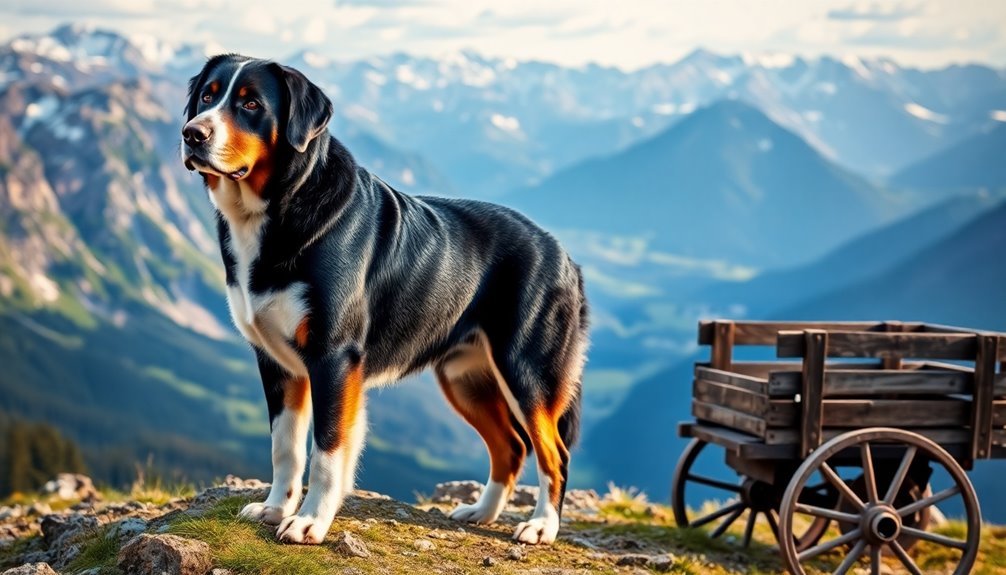
Introducing the Great Swiss Mountain Dog, you'll find a breed that embodies strength and loyalty. Standing between 24 to 28 inches tall and weighing between 110 to 150 pounds, these sturdy dogs are built for both work and companionship. Their broad skull and blunt muzzle give them a distinctive appearance, while their high-set, rounded ears add to their charm.
In temperament, they're good-natured and protective, making them excellent family pets. You'll appreciate their affectionate nature indoors, where they can be calm and snuggly. However, they also thrive on outdoor activities like hiking and exploring. Their high-energy nature means they require mental and physical stimulation to keep them happy and healthy.
Their social and outgoing personality allows them to bond well with families, though they can show independence at times. With strong nerves and confidence, they're alert and ready to protect their home.
While they're eager to please, you'll need to be aware of their stubborn streak, which requires early obedience training. Establishing clear leadership is crucial to prevent any dominant behaviors.
History and Origin

The Great Swiss Mountain Dog traces its roots back to ancient times, when large Mastiff-type dogs accompanied Roman Legions in the 1st century B.C. Developed in the Swiss Alps, these dogs served as essential draft animals for farmers, showcasing their strength and versatility. Their lineage is believed to be influenced by Roman dogs, which were bred with local breeds, leading to the modern Swiss Sennenhunds. Understanding their history helps you appreciate how they've become the loyal companions they're today.
Where and when the breed originated
Great Swiss Mountain Dogs have ancient origins that trace back to the Mollasian, a large Mastiff-type dog that accompanied Roman legions as early as the 1st century B.C. Some believe that Phoenicians introduced a large breed to Spain around 1100 B.C., which later influenced various European breeds.
Additionally, there's evidence suggesting that a large breed indigenous to central Europe existed as far back as the Neolithic period. As Romans settled in the Alps, they bred these dogs with local breeds, further shaping their characteristics.
In Switzerland, the Great Swiss Mountain Dog developed into a reliable working dog for farmers, herders, butchers, and cattle dealers. By 1908, Professor Albert Heim recognized them as a distinct breed, and the Swiss Stud Book listed them in 1909. This breed is recognized by the United Kennel Club since 1992, showcasing their importance in the canine world.
A dedicated breed club was established in 1912, further promoting their significance. The breed gained historical recognition when the FCI published the breed standard in 1939, acknowledging their role as dependable draught dogs during WWII.
Draft Animal for Farmers
For centuries, the Great Swiss Mountain Dog has served as a vital draft animal for farmers, showcasing its strength and reliability. You'd find these dogs pulling heavy carts from dairy farms to local markets, transporting goods like meat and milk, and even carrying supplies during wartime over challenging mountain terrains.
Often referred to as the "poor man's horse," their draft capabilities allowed farmers to complete tasks typically reserved for horses.
In addition to their drafting duties, these dogs also herded livestock, guarded properties, and checked on crops and equipment, providing essential support to farmers. Their calm demeanor and strong will make them well-suited for such responsibilities, as they navigate obstacles while pulling carts steadily. The breed's working ability has been essential for farmers throughout history, ensuring their livelihoods were supported by these loyal companions.
Today, modern practices recognize their historical significance. Draft tests assess their proficiency in traditional tasks, and dogs can earn titles like Novice Draft Dog (NDD) and Draft Dog (DD).
Additionally, team titles highlight the effectiveness of two dogs working together. Recognized by organizations like the AKC and UKC, efforts continue to celebrate and promote the Great Swiss Mountain Dog's remarkable history and contributions as a dependable draft animal.
Physical Characteristics
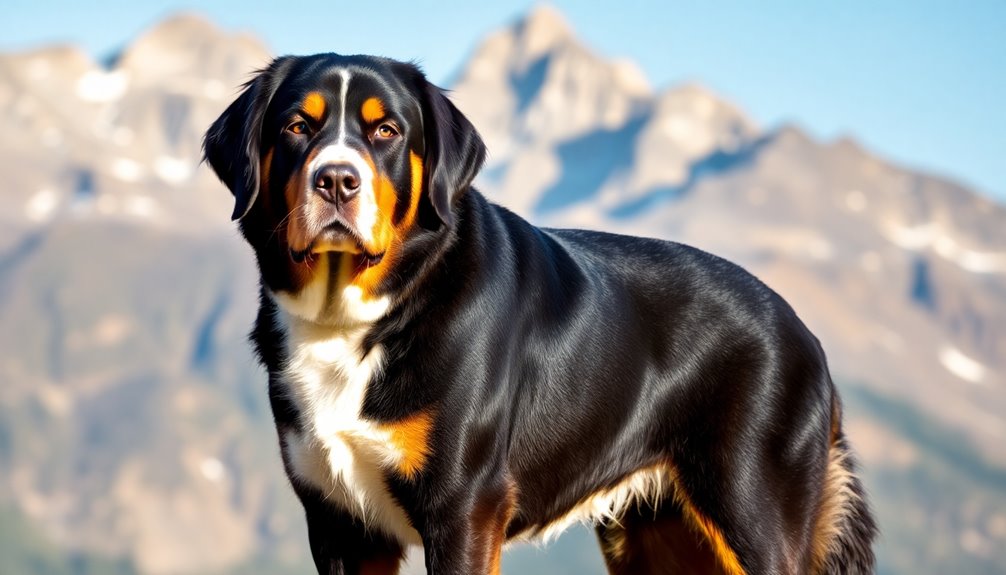
When you look at the Great Swiss Mountain Dog, you'll notice its impressive size and sturdy build, typically weighing between 85 to 140 pounds. Its thick, bushy tail adds to its striking appearance, balancing the broad chest and strong legs. The coat, often a combination of black, white, and rust, isn't just for show; it provides insulation against harsh weather conditions. These dogs are known for their gentleness and loyalty, making them excellent family companions.
Size, weight, and coat details
The Great Swiss Mountain Dog is a striking breed, known for its impressive size and robust build. Males typically stand between 25.5 to 28.5 inches tall at the shoulder, while females range from 23.5 to 27 inches. This breed maintains a body length to height ratio of approximately 10 to 9, contributing to its powerful stance.
When it comes to weight, males usually weigh between 115 and 140 pounds, with females ranging from 85 to 110 pounds. The weight can vary based on exercise, genetics, diet, and overall health, so it's essential to keep an eye on your dog's condition.
Their coat is equally distinctive, featuring a base color of black adorned with tan points and white markings. You'll notice white on their feet, chest, tip of the tail, and muzzle, along with tan markings on the cheeks, above the eyes, and on the legs. This breed's coat colors must adhere to strict guidelines, ensuring only black, red, and white tri-color are accepted.
The dense, close-lying double coat has an outer layer of medium length, while the undercoat can range from dark gray to tawny, with darker gray preferred. This combination not only gives them a stunning appearance but also helps them adapt to various climates.
Thick, Bushy Tail
With its thick, bushy tail, the Great Swiss Mountain Dog showcases a distinctive physical characteristic that complements its powerful build. This tail is straight and robust, barely tapering toward the tip, and typically reaches down to the hock when the dog is at rest. Set on the natural line of the croup, it hangs low, giving a relaxed appearance.
When alert or in motion, you'll notice the tail carried higher, sometimes curving slightly upward, indicating the dog's excitement or engagement. During its quiet moments, the tail remains pendulous, never curling or arching over the back. Its movement reflects the dog's mood; a higher position signifies alertness, while a low, straight tail shows calmness.
You won't see any excessive wagging or erratic movements, making the tail a reliable indicator of the dog's emotional state. Regular grooming helps keep the tail area clean and free of debris, although it doesn't require special care beyond general grooming. *This breed's moderate exercise needs can influence overall tail health, as proper activity supports muscle tone and posture.*
You can use shedding blades or de-shedding tools to manage shedding, ensuring the overall coat, including the tail, stays healthy and well-maintained.
Temperament and Personality
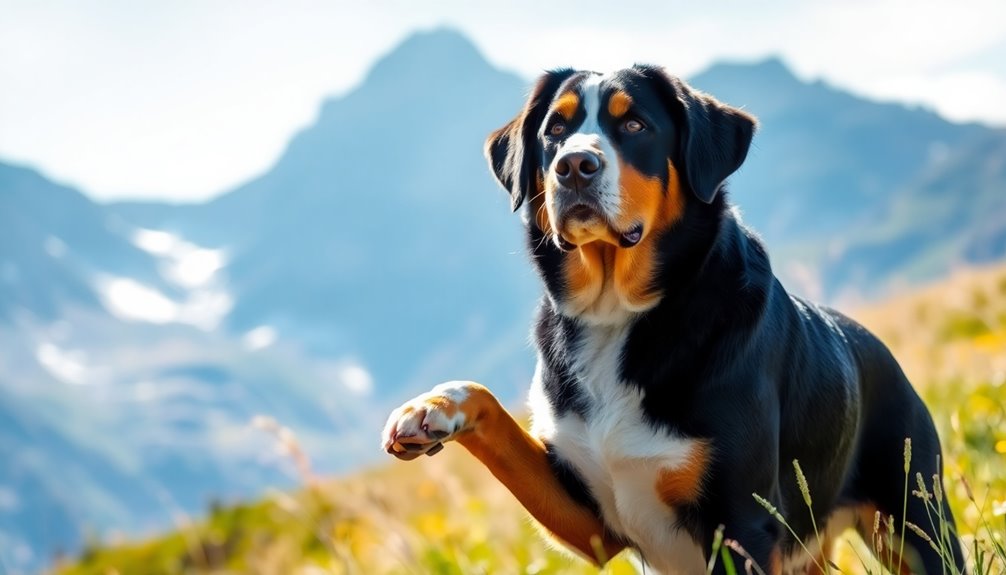
When you bring a Great Swiss Mountain Dog into your home, you're inviting a gentle giant that's particularly kind to both children and other pets. Their friendly nature makes them an excellent choice for families and individuals alike, ensuring everyone feels included. With the right socialization, these dogs thrive in diverse environments, forming strong bonds with everyone around them. Their loyalty and intelligence make them not only devoted companions but also relatively easy to train when approached with patience and consistency.
Gentle With Children and Pets
Known for their gentle disposition, Greater Swiss Mountain Dogs are fantastic companions for families, especially those with children. Their friendly and outgoing nature makes them eager to meet new people, and they often form strong bonds with kids.
Despite their large size, these dogs are known for their patience and gentleness, making playtime enjoyable for little ones. However, because they can be enthusiastic, it's essential to supervise their interactions with younger children to prevent accidental tumbles.
When it comes to other pets, Greater Swiss Mountain Dogs generally do well, provided they're properly introduced. Early socialization is crucial to help them learn appropriate behavior around other animals. In fact, they are known to be social and friendly, which allows them to adapt well in a household with multiple pets.
While they've a natural herding instinct and a bit of a prey drive, they can coexist peacefully with cats and other pets when trained consistently. Their affectionate demeanor allows them to be loving companions, and with positive reinforcement training, they respond well to commands.
Suitability for families, individuals, or other pets
Greater Swiss Mountain Dogs are well-suited for various living situations, whether in a bustling family home or with individuals seeking a loyal companion. Their loyalty and affectionate nature make them ideal family pets, as they thrive on involvement in family activities, from hiking to lounging on the couch. Regular veterinary check-ups are essential for maintaining their overall health and preventing common issues.
Early socialization is crucial to help them adapt well to different environments and other pets. For individuals, these dogs bring a sense of independence and a protective instinct towards their families, though they may be wary of strangers. They need regular physical and mental stimulation due to their hardworking background, and sufficient space to roam comfortably is essential.
When it comes to other pets, Greater Swiss Mountain Dogs possess a strong herding instinct, so training is necessary to prevent chasing smaller animals. Proper socialization ensures they interact positively with other pets, and supervision during their interactions is key to maintaining harmony. With their generally friendly temperament, these dogs can become loving companions for families and individuals alike, provided they receive consistent training and social exposure.
Health and Lifespan
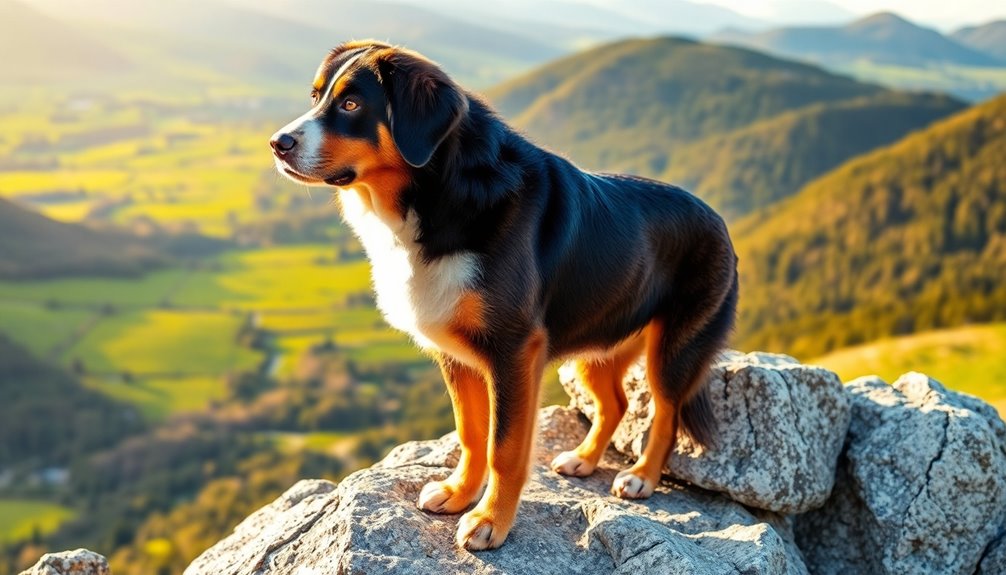
When it comes to the health and lifespan of the Great Swiss Mountain Dog, you'll find that their average lifespan ranges from 8 to 11 years, though some may live even longer. They're prone to certain health issues, like hip dysplasia and cancers, which can impact their quality of life. To keep your furry friend healthy, regular check-ups and a balanced diet are essential. Additionally, awareness of common health risks such as bloat and urinary incontinence can help in proactively managing their well-being.
Typical lifespan of the breed
With an average lifespan of 8 to 11 years, the Greater Swiss Mountain Dog typically reflects the trends seen in larger breeds, where size often correlates with longevity. While some sources cite a median lifespan of around 6.75 years, most healthy individuals can live well beyond that, with some seniors reaching past 10 years.
Several factors influence their lifespan. Genetics play a significant role, and the breed's larger size generally means a shorter lifespan compared to smaller dogs. Health conditions, such as splenic torsion and epilepsy, can affect how long your dog lives. Additionally, it's important to consider that the breed is not as prone to common health issues affecting large pedigree dogs, which can benefit their overall longevity.
Additionally, geographic and environmental elements may lead to variations in lifespan across different regions.
It's important to note that overall health and wellness significantly contribute to longevity. With proper care, you might find that your Greater Swiss Mountain Dog thrives well into its senior years.
Compared to other large breeds, the lifespan of the Greater Swiss Mountain Dog is relatively average, aligning with expectations for dogs of this size and build. By understanding these factors, you can help ensure a happy and healthy life for your canine companion.
Common health concerns or genetic predispositions
Many owners of Greater Swiss Mountain Dogs find themselves concerned about certain health issues that can impact their furry friends. One of the most common genetic predispositions in this breed is lymphoma, a type of cancer affecting lymphocytes. Additionally, hip and elbow dysplasia are inherited conditions that can lead to arthritis and lameness, while osteochondritis dissecans of the shoulder may cause pain and mobility issues.
Gastrointestinal health is another area of concern. Gastric torsion, or bloat, is life-threatening and requires immediate attention. Other gastrointestinal problems can also significantly affect your dog's health. Regular veterinary check-ups are essential for early detection of these issues.
Neurological conditions like epilepsy are common, and various musculoskeletal issues can arise, including arthritis, which often results from joint dysplasia.
The breed's low genetic diversity further complicates health matters, increasing the likelihood of inbreeding and associated genetic health issues.
It's crucial to stay informed and monitor your Greater Swiss Mountain Dog for any signs of these conditions. By understanding these health concerns, you can be proactive in ensuring your furry companion leads a happy and healthy life.
Tips for maintaining health and wellness
Keeping your Greater Swiss Mountain Dog healthy and happy requires a proactive approach to their overall wellness. Start with their diet; provide a high-quality, nutritionally balanced canine food suited for their life stage. Split their meals into two measured servings daily, and avoid excessive treats to prevent obesity, which can lead to health issues.
Exercise is vital too. Aim for about an hour of physical activity each day, incorporating walks, hikes, and fetch games. Remember, they prefer leisurely hikes over long-distance running and can be sensitive to heat, so keep outdoor sessions brief during hot weather. This breed's moderate exercise needs make them well-suited for families who enjoy outdoor activities together.
Grooming and hygiene play a significant role in their health. Brush their coat weekly, increasing to daily during shedding season, and bathe them no more than once every two months. Trim their nails monthly and establish a routine of daily teeth brushing to fend off gum disease.
Finally, regular vet check-ups are essential for early detection of health concerns. Monitor their weight closely and provide fresh water at all times. Adjust care routines as needed, especially as they age, to maintain their well-being throughout their average lifespan of 8-11 years.
Care Requirements
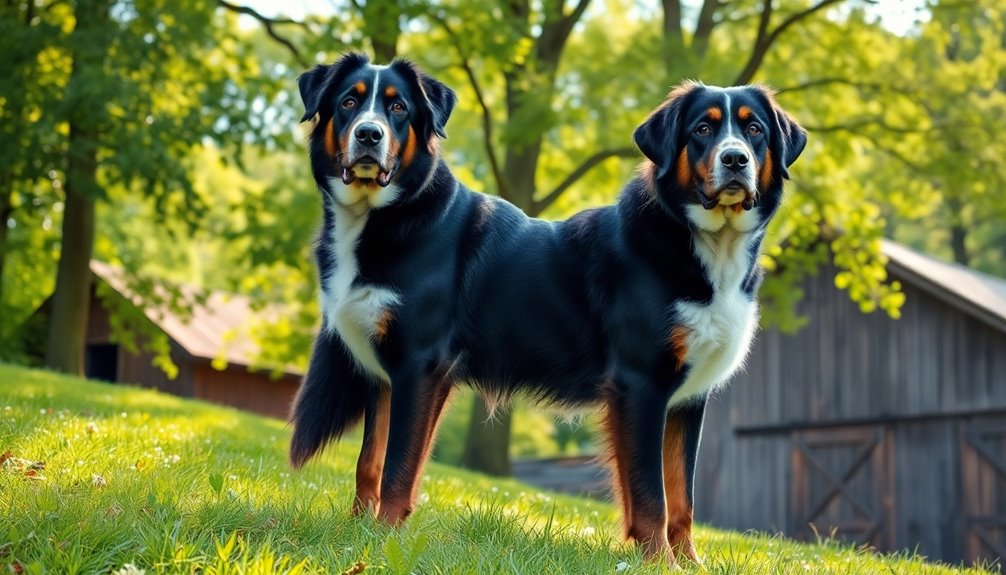
Caring for your Great Swiss Mountain Dog involves regular grooming, including brushing their coat at least once a week. It is also important to incorporate regular ear checks to maintain their overall health and prevent any potential issues. You'll also need to ensure they get at least 30 minutes of exercise daily to keep them healthy and happy. Lastly, providing a balanced diet tailored to their age and energy level is crucial for their overall well-being.
Brushing Frequency: Weekly Required
To maintain the health and appearance of your Greater Swiss Mountain Dog's coat, weekly brushing is essential. By using a slicker brush or a pin brush, you can effectively remove loose hair and debris while preventing matting. This routine not only promotes a shiny coat but also supports healthy skin.
Keep in mind that Greater Swiss Mountain Dogs are moderate shedders year-round, but they experience heavy shedding in the spring and fall. During these seasons, you might need to brush daily, especially with a deshedding tool like the FURminator, to manage the increased shedding efficiently.
Regular brushing also helps minimize shedding overall, ensuring your home stays cleaner and your dog remains comfortable. Additionally, it's important to remember that regular grooming fosters a strong bond between you and your dog, enhancing your relationship.
Don't forget to check their ears weekly and trim their nails monthly to maintain overall hygiene.
If you have a puppy, start introducing them to brushing early, around 8 to 12 weeks. Keep sessions short and use positive reinforcement to create a positive grooming experience.
This way, your Greater Swiss Mountain Dog will grow accustomed to grooming and enjoy the process, making maintenance easier for both of you.
Exercise requirements and energy levels
A Greater Swiss Mountain Dog thrives on regular exercise to maintain its physical health and mental well-being. You should aim for at least 30 minutes of brisk walking or a leisurely hike each day. In total, they need about an hour of physical activity daily, which can include walks, hikes, and games like fetch.
While they can manage with walks once or twice a day, they're also capable of handling more rigorous exercise schedules. Engaging in activities such as walking in the woods, playing fetch at the dog park, or swimming will keep your Swissy happy and healthy.
Interactive games like hide-and-seek and puzzle toys can also provide mental stimulation indoors. Keep in mind their age and health; avoid extreme exercise for young puppies to prevent bone and joint issues.
As they grow, gradually increase their walking routine. Be cautious of extreme heat, as Swissys are sensitive to it. Limit outdoor sessions during hot weather and ensure they've access to shade and fresh water. Furthermore, maintaining a proper weight is crucial to avoid obesity-related health problems that can arise from insufficient exercise.
With the right balance of exercise, your Greater Swiss Mountain Dog will be a strong and gentle companion.
Feeding tips and diet recommendations
Maintaining your Greater Swiss Mountain Dog's health goes beyond exercise; a proper diet is key. Start with high-quality proteins, such as chicken, beef, or fish, as the first ingredient in their food. For adults, aim for a diet containing 18-25% protein and 12-15% healthy fats, including Omega-3 and Omega-6 fatty acids.
Puppies need a bit more, with 25-27% protein and slightly higher fat content. Feed your adult dog 4 to 5 cups of high-quality dog food daily, split into two meals. Puppies require smaller, more frequent meals—about three times a day—until they're six months old, eventually consuming around 5-6 cups daily.
For seniors, consider a lower-calorie diet with more fiber and joint-supporting nutrients like glucosamine. Additionally, regular monitoring of weight is essential for ensuring that your dog's dietary needs are met as they age. If you opt for a raw diet, ensure it includes high-quality animal proteins and avoids artificial additives.
Aim to mimic a wolf's natural diet, balancing meat, bones, offal, and small plant ingredients. Adjust feeding quantities based on your dog's age, size, and activity level to support their health at every life stage.
Training and Socialization
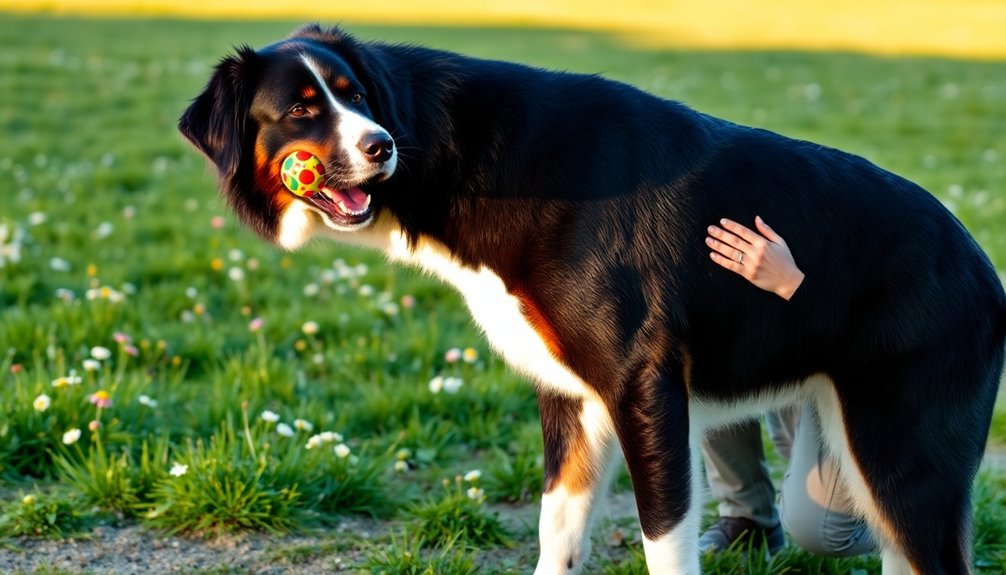
When training your Greater Swiss Mountain Dog, you'll find they're moderately responsive to commands, so consistency is key. Gradually introducing them to new environments can help build their confidence and reduce leash pulling during walks. With patience and the right techniques, you can create a well-behaved companion ready to explore the world with you. Incorporating positive reinforcement into your training sessions will significantly enhance their learning experience. Additionally, engaging in regular pet therapy activities can further promote their emotional well-being and strengthen your bond.
Moderately Responsive to Commands
Training a Great Swiss Mountain Dog requires patience and consistency, as they're moderately responsive to commands. You'll find that positive reinforcement works best, so reward your dog with treats and praise when they follow your commands.
Start with basic obedience commands like sit, stay, come, and heel. Keep your training sessions short, fun, and upbeat to maintain their focus and enthusiasm. Consistency is key, so repeat commands regularly to reinforce learning.
Early training is essential, especially for leash manners to prevent pulling during walks. As they progress, you can introduce more advanced commands like fetch, roll over, and shake. However, be prepared for these to require more patience and repetition.
Socialization is also crucial; it helps them develop confidence and friendliness towards non-threatening strangers and other dogs. They may have a strong herding drive, so you'll need to direct their energy appropriately to avoid chasing small animals. This breed's strong herding instincts can make it vital to guide them during socialization to prevent unwanted behaviors.
Establish yourself as a good leader, and they'll thrive in your home environment while remaining engaged and eager to learn. With the right approach, your Great Swiss Mountain Dog can become a well-behaved companion.
Gradual Introductions to New Environments
During the crucial early weeks of a Great Swiss Mountain Dog's life, gradual introductions to new environments play a vital role in shaping their behavior. From 3 to 14 weeks, exposing your puppy to various people, animals, and settings helps develop their confidence and adaptability. This early socialization reduces the likelihood of fear-based behaviors and aggression, preventing anxiety by familiarizing them with different noises and surfaces. Additionally, their intelligence and eagerness to please make them highly receptive to training during this period.
Regularly introduce your pup to a diverse range of experiences, ensuring to create positive associations through rewarding interactions. Consider enrolling in socialization classes that provide a structured environment where your dog can learn essential skills.
When introducing new pets or family members, take it slow; monitor their interactions closely and intervene if necessary to maintain harmony.
Utilize positive reinforcement techniques, such as treats and verbal praise, to establish a trusting relationship. Consistent training focusing on basic commands like sit, stay, and come not only provides mental stimulation but also sets clear expectations.
Leash Pulling During Walks
Leash pulling can turn a simple walk into a frustrating tug-of-war, making it essential to address this behavior early on with your Greater Swiss Mountain Dog.
Start by stopping immediately when your dog pulls on the leash. This prevents them from getting the reward of moving forward. Wait for the leash to become slack and for your dog to focus back on you before continuing. When they do, reward them with treats and praise.
Consistency is key; maintain the no-pulling rule even in tempting situations. Keep training sessions short and fun to keep your dog engaged. To ensure lasting results, regular reinforcement of commands helps maintain desired leash behavior.
Consider using front-hook harnesses or head halters to help manage their pulling. Utilizing leash pressure can guide them into the desired position, like walking by your side.
Incorporate basic obedience commands to help manage leash reactivity, and gradually expose your dog to controlled distractions.
Positive reinforcement is essential, so reward good behavior with treats and praise. With patience and the right techniques, you'll foster a more enjoyable walking experience with your Greater Swiss Mountain Dog.
Ideal Living Environment
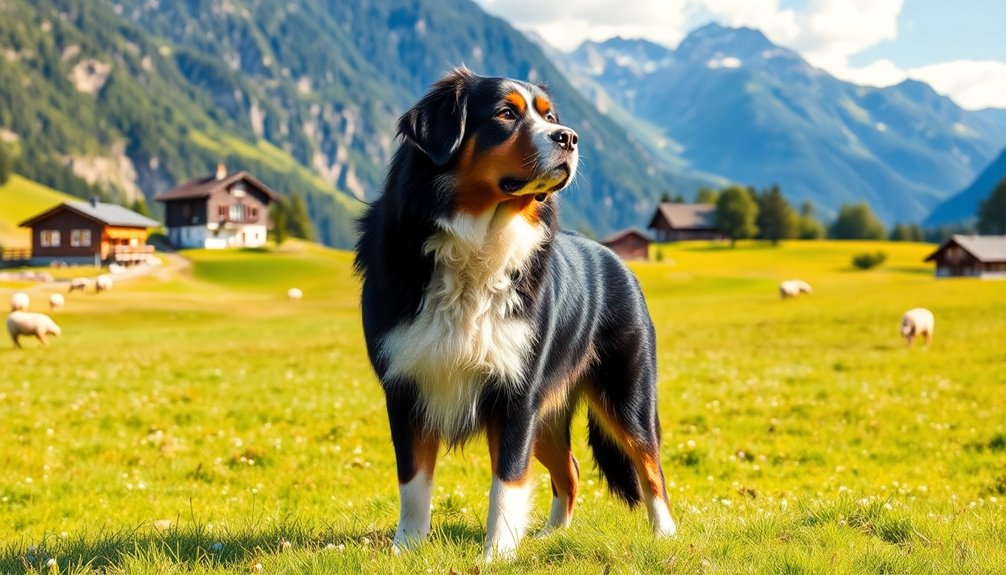
Your Great Swiss Mountain Dog thrives in a spacious home with easy outdoor access, where they can roam freely. They prefer cooler, mountainous climates that mimic their natural habitat, so keep this in mind when considering your living environment. A well-insulated shelter and plenty of green space will help keep them happy and healthy. Their moderate exercise needs mean they will appreciate having room to play and explore in a safe environment.
Spacious Home With Outdoor Access
A spacious home with outdoor access is essential for a Great Swiss Mountain Dog's happiness and well-being. These dogs need ample indoor space to move around comfortably, rest, and relax. A small apartment simply won't cut it for this large breed.
You'll want to create an environment that allows for interactive puzzle toys and indoor games, as well as room for your dog to lie down and stretch out.
Outdoor access is equally vital. Great Swiss Mountain Dogs thrive on regular outdoor activities, and having a secure, large yard for playtime is a significant advantage. They enjoy walks, hikes, and visits to dog parks, and they need shaded areas to cool down during warm months. Additionally, their cold hardiness makes them well-suited for outdoor adventures in winter conditions.
Engaging in activities such as hiking, camping, and playing tug of war will keep them physically and mentally stimulated.
A balanced exercise routine is crucial, as it helps prevent obesity and promotes overall health. Aim for daily walks of at least 30 minutes and consider introducing them to swimming positively.
Prefers Cooler, Mountainous Climates
Great Swiss Mountain Dogs thrive in cooler, mountainous climates, where their thick double coats can keep them comfortable and protect them from harsh weather.
These dogs aren't suited for heat; temperatures over 80 degrees can quickly lead to heat exhaustion or stroke. You'll need to avoid walks during the hottest parts of the day and ensure they've access to air conditioning during summer. Hot pavement can reach dangerous temperatures, so consider protective footwear if you have to go out. To ensure their safety, it's important to understand canine heat response and recognize signs of overheating.
On the other hand, they flourish in cold environments. Their dense fur shields them from frigid temperatures and wet conditions, making snowy adventures a joy.
Historically bred to work in the Swiss Alps, they enjoy activities like hiking, herding, and weight pulling, especially in winter.
While they need at least one or two walks daily, more vigorous exercise is ideal when the weather is cool.
Always provide a warm, dry shelter for them during extended outdoor stays in cold weather. By understanding their climate preferences, you can ensure your Greater Swiss Mountain Dog leads a happy, healthy life.
Versatile in Draft Work
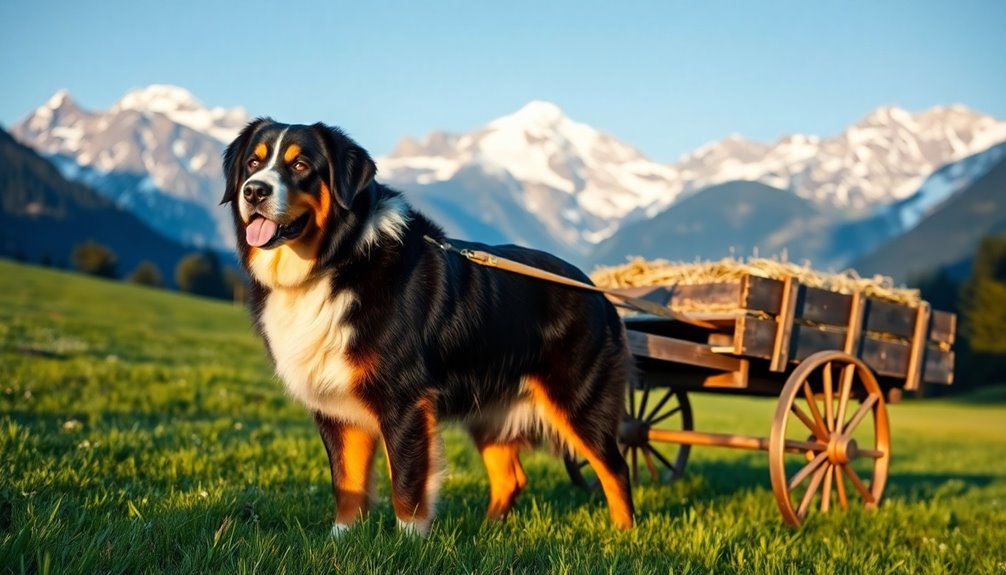
When you think of the Great Swiss Mountain Dog, consider its remarkable ability to thrive in cold weather while performing versatile draft work. These dogs not only excel at pulling heavy loads but also showcase their strength and resilience in challenging conditions. Their historical role in agriculture and trade highlights their importance, making them a true canine co-star in both work and companionship.
Exceptional Cold Weather Tolerance
Although many breeds struggle in frigid temperatures, the Great Swiss Mountain Dog thrives in cold weather thanks to its remarkable physical adaptations. Its thick double coat provides excellent insulation, while the dense, short fur—colored in black, white, and rust—enhances cold weather tolerance.
With a higher body fat percentage, this breed enjoys built-in insulation that keeps it warm during harsh conditions. The water-resistant coat protects against moisture and wind chill, making it highly efficient in icy environments.
Designed for draft work, these dogs historically pulled heavy carts from dairy farms to markets in Switzerland. Their endurance allows them to perform various tasks in cold climates, whether pulling carts or guarding livestock.
You'll notice their teamwork skills shine as they work with handlers to navigate obstacles. It's important to remember that individual assessment is crucial for outdoor safety decisions, especially in extreme weather conditions.
While they can stay outdoors for 30 minutes to an hour in temperatures below 32ºF, healthy Great Swiss Mountain Dogs acclimate well and can manage longer periods outside.
Just ensure they've access to shelter from extreme weather and adjust their diet with extra calories during colder months to support their energy needs.
Hollywood's Canine Co-Star
Throughout history, the Great Swiss Mountain Dog has played a vital role as a versatile draft worker, showcasing its strength and endurance on Swiss farms. Bred to assist with livestock management and pull heavy carts, these dogs have a rich history in agriculture.
They've herded dairy cows, hauled produce, and even given farmers a lift home after long days of work. Today, they continue to shine in modern drafting activities. You can see them participating in draft tests that replicate historical tasks, engaging in yard work, and even pulling carts in local parades. Additionally, their involvement in local parades helps promote community engagement and enjoyment.
Their immense strength and agility allow them to move heavy loads with ease, and their built-in desire to pull makes them natural draft workers. Training is essential, as it can take time for them to learn commands and perfect their skills.
They can earn various draft titles, showcasing their proficiency and teamwork with handlers. Watching a Great Swiss Mountain Dog in action, whether giving wagon rides to children or navigating a challenging course, highlights their versatility and dedication, proving that these gentle giants aren't just farm workers but also Hollywood's canine co-stars.
Ideal for Active Lifestyles?
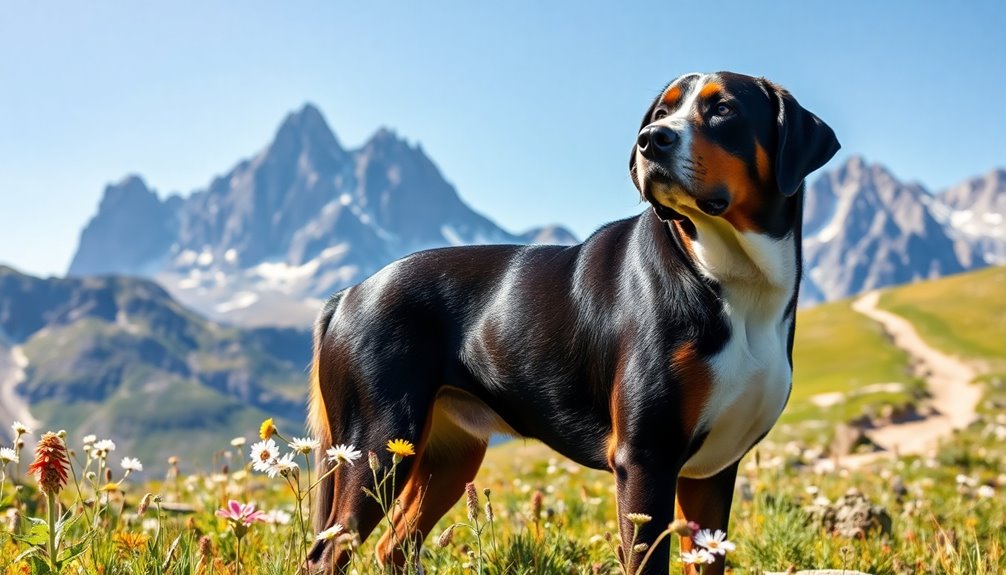
If you lead an active family lifestyle, the Great Swiss Mountain Dog could be a perfect fit for you.
They thrive on daily exercise, enjoying walks, hikes, and playtime that can be easily woven into your routine. Additionally, their core features support accurate classification, making them easily recognizable and distinct among other breeds. Their ability to adapt to various activities, such as quick breakfast options, ensures they can accompany you on your morning adventures. Committing to their exercise needs not only keeps them healthy but also strengthens your bond as a family.
Great for Active Families
Engaging in outdoor activities with a Great Swiss Mountain Dog can be a rewarding experience for active families. Their affectionate and calm demeanor makes them perfect companions for family life, creating strong bonds with both children and adults.
While their large size requires supervision around young kids, their gentle nature ensures interactions are loving and positive. These dogs thrive in various environments, excelling at hiking and enjoying trips to parks or camping adventures. They're not just about physical activity; mental stimulation also matters. Interactive puzzle toys and games like hide-and-seek keep their minds sharp, and engaging in activities that reflect their historical roles can further enhance their happiness. Additionally, incorporating transformative possibilities into their routines can lead to improved overall well-being.
Early socialization plays a vital role in helping them interact confidently with people and other pets, ensuring they remain friendly and well-adjusted. When you provide consistent training and positive reinforcement, you'll find they're eager to please. This breed benefits from routine and structure, making them reliable companions during your family outings.
By integrating them into your active lifestyle, you'll not only enjoy outdoor adventures together but also strengthen the family bond that these loyal dogs cherish. With the right approach, a Great Swiss Mountain Dog becomes an integral part of your family's active journey.
Commitment to Daily Exercise
A Great Swiss Mountain Dog thrives on daily exercise, making it a great fit for families with active lifestyles.
You'll need to commit at least 60 to 90 minutes each day to keep your dog physically and mentally stimulated. This could include brisk walks, hikes, or playtime in a secure yard. Engaging in structured activities like agility or obedience trials will further satisfy their high-energy needs. Regular daily exercise is crucial for physical health and well-being.
As your dog ages, adjust the intensity of their exercise. Puppies require shorter, gentler sessions to protect their developing joints, while older dogs benefit from regular, low-impact activities.
It's crucial to balance high-energy exercises with rest, ensuring your dog doesn't become overtired.
Interactive games and indoor activities, such as hide-and-seek or puzzle toys, can help manage pent-up energy when outdoor time is limited. If your schedule's tight, consider using a treadmill as an alternative.
Regular exercise not only helps maintain a healthy weight but also promotes joint health and overall fitness.
Frequently Asked Questions
What Is the Typical Lifespan of a Great Swiss Mountain Dog?
The typical lifespan of a Greater Swiss Mountain Dog ranges from about 8 to 11 years, with some living up to 12 or even 14 years.
However, individual lifespans can vary due to factors like size, health, and breeding practices.
You should be aware that larger breeds often face shorter lifespans and are prone to specific health issues.
Regular veterinary care and a healthy lifestyle can help improve their quality of life and longevity.
Are Great Swiss Mountain Dogs Good With Children?
Yes, Great Swiss Mountain Dogs are generally great with children. Their calm and gentle nature makes them excellent companions for kids.
With early socialization, they become patient and tolerant, ensuring positive interactions. It's essential to supervise their playtime and teach kids to respect the dog's space.
You'll find that these dogs are protective and loyal, always looking out for your family, making them a wonderful addition to any household with children.
How Much Exercise Does a Great Swiss Mountain Dog Need?
A Great Swiss Mountain Dog needs about 30 minutes to an hour of exercise each day.
You can take them on brisk walks, enjoy leisurely hikes, or play fetch to keep them active.
It's essential to spread out their exercise to prevent overexertion.
While they thrive in cooler climates, be cautious in hot weather and limit activities to early mornings or evenings.
Keeping them mentally stimulated is just as important for their overall well-being!
What Grooming Needs Do Great Swiss Mountain Dogs Have?
Great Swiss Mountain Dogs need regular grooming to keep their coats healthy and free of mats. You should brush their coat at least once a week, increasing frequency during shedding seasons.
Bathe them every two to three months using mild dog shampoo, ensuring you rinse and dry thoroughly.
Don't forget to check their ears, trim nails, and maintain dental hygiene for overall health.
Introducing grooming early with positive reinforcement can make the process enjoyable.
Can Great Swiss Mountain Dogs Live in Apartments?
Great Swiss Mountain Dogs aren't ideal for apartment living.
They need plenty of space to roam, play, and bark, making suburban or rural environments a better fit.
While you could manage in an apartment with sufficient exercise, it's not the best scenario for them.
They thrive in areas where they can engage in physical activities, so consider your living situation before bringing one into your home.
Conclusion
In conclusion, the Great Swiss Mountain Dog is a remarkable companion, blending strength with gentleness. With their rich history and versatile abilities, they fit perfectly into active lifestyles. These loyal dogs thrive in environments where they can work and play, making them ideal for families and outdoor enthusiasts alike. By understanding their needs and providing proper training, you'll enjoy a fulfilling relationship with your Swissy, ensuring a happy, healthy life together.

